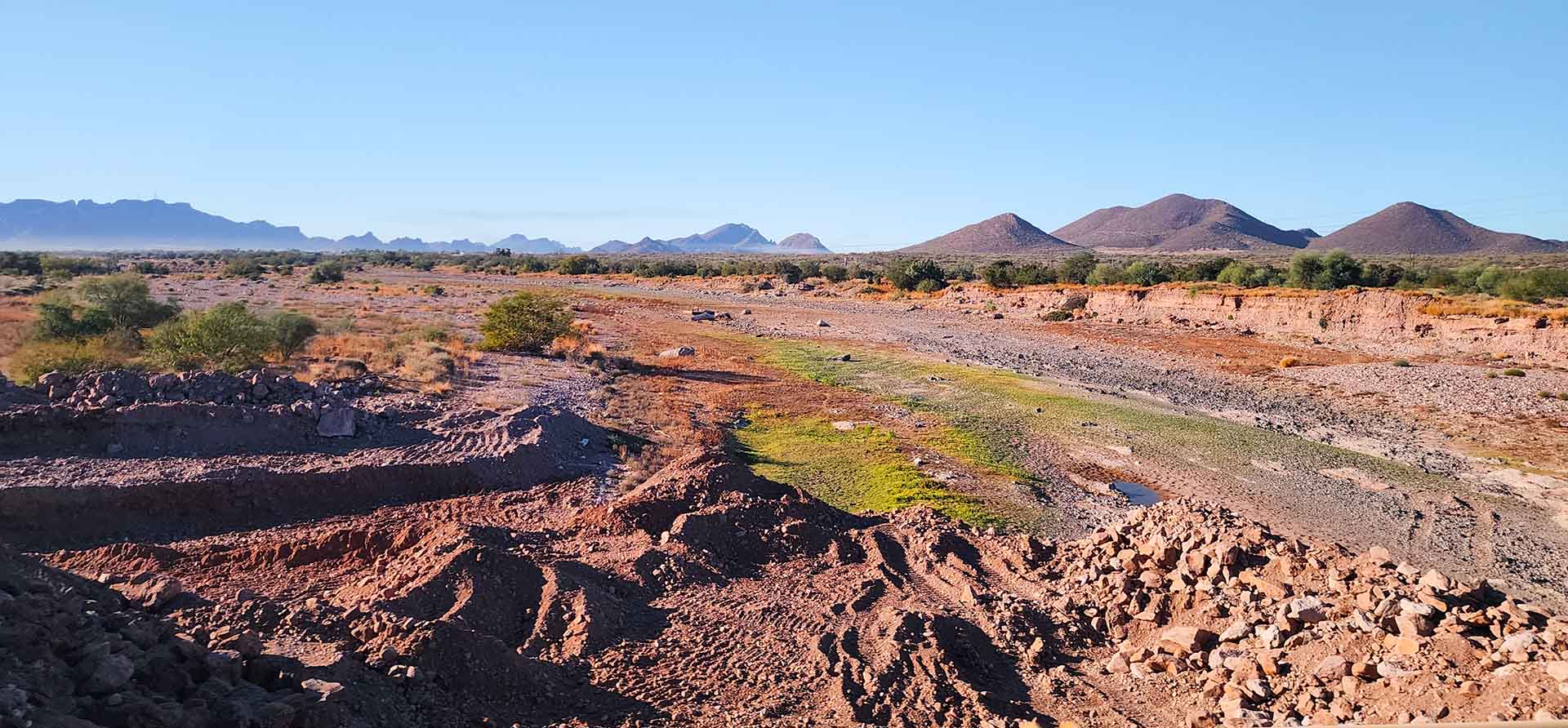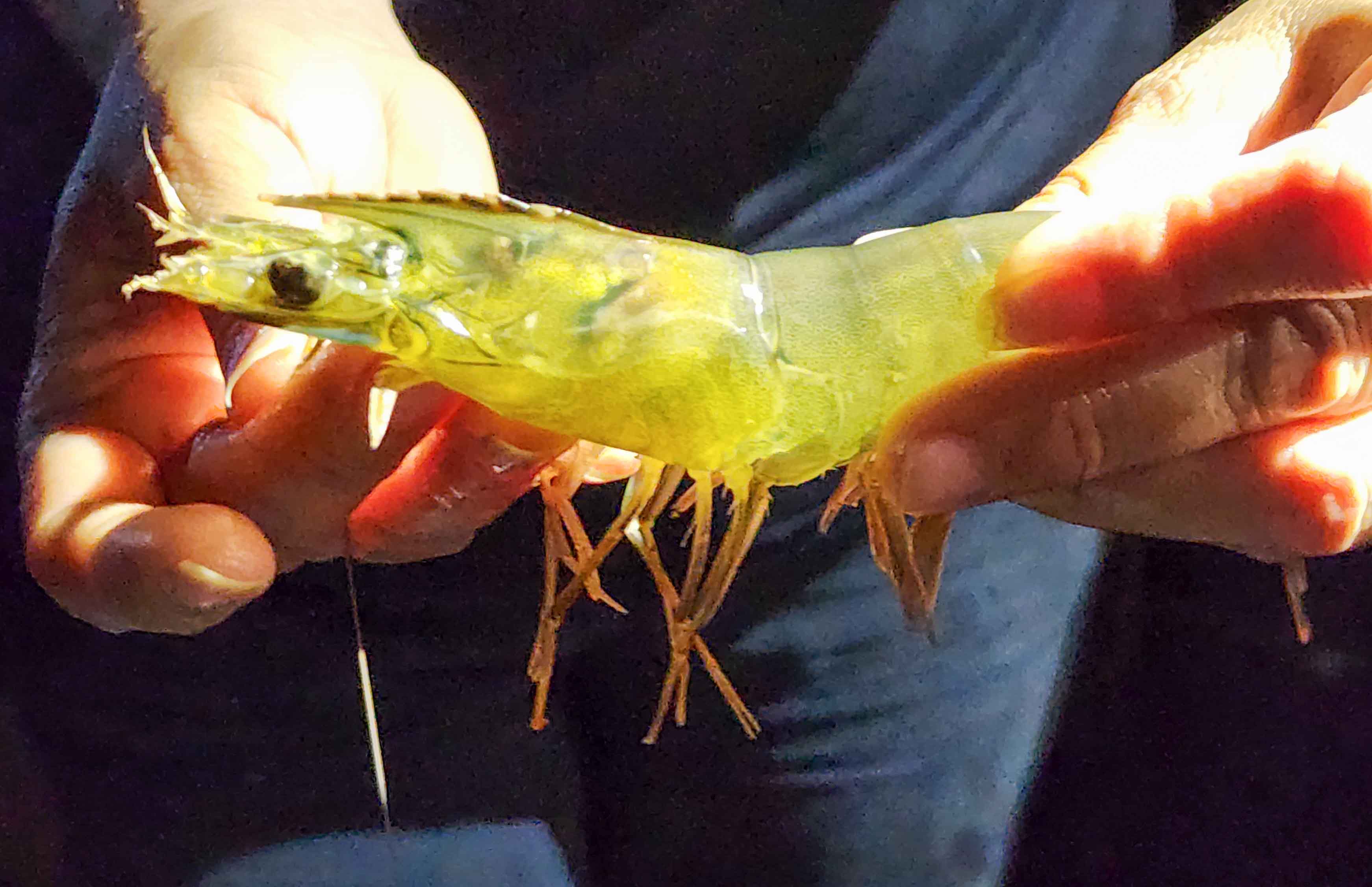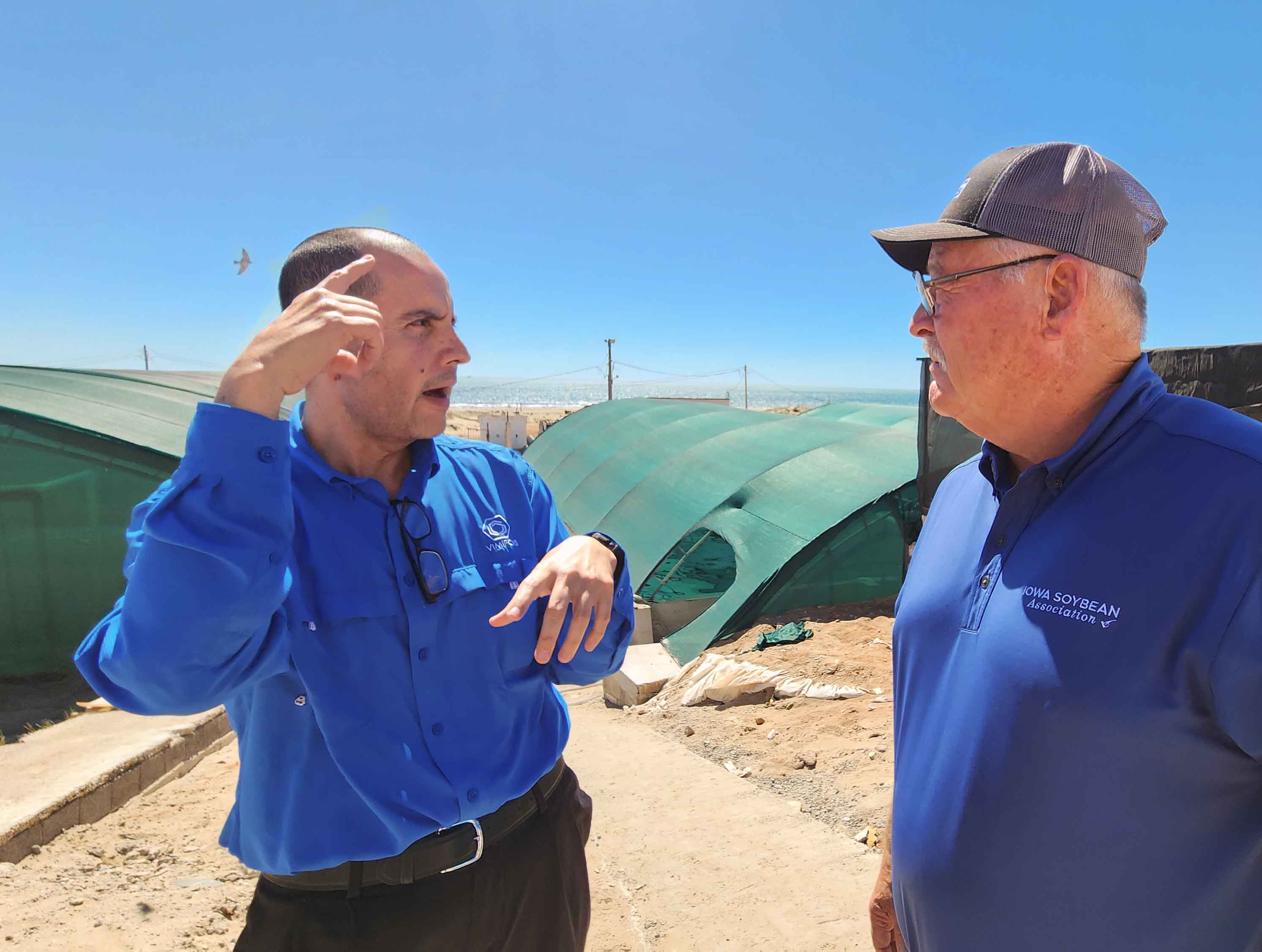
Soybean leaders from Iowa, Nebraska, Kansas and Missouri at a shrimp hatchery operated by Mexico-based Vimifos. (Photo: Iowa Soybean Association / Aaron Putze, APR)
Mexico brings soy to shrimp
April 30, 2024 | Aaron Putze, APR
The landscape looks more like Mars than the world’s second largest consumer of U.S. soybeans. Dust-coated vegetation, dry riverbeds, large swaths of lifeless land and dancing heat waves simmer from pavement. Little moves, and what does moves as little as possible.
From inside an unmarked Sprinter van washed daily yet still showing signs of wear, a dozen representatives of the U.S. soy industry traverse the rugged northwest countryside of Mexico in search of buyers and users of Midwest-sourced soybeans.

With global soybean supplies ample and cash prices in places like Hubbard, Montezuma, Algona and Fairbank trending lower, finding markets takes effort — and being oblivious to motion sickness.
Among those bouncing from place to place south of the U.S. border is Warren Bachman. The farmer from Osceola has harvested north of 60 soybean crops and is committed to helping find markets for a growing supply of the popular and versatile commodity.
The Iowa Soybean Association (ISA) board member pays close attention to the countryside zooming by. He’s an expert on knowing nearly every make and model of harvesting equipment, even those scattered throughout Mexico’s parched and sparsely populated rural communities stretching from Hermosilla to Culiacan (a distance of about 428 miles).
For many years, Warren traversed the southern U.S. gobbling up wheat acres as part of custom threshing operations. Today, he seeks to harvest new marketing opportunities for fellow Iowa soybean farmers.
“It’s dry, even in places where agriculture is king,” he muses while scanning the pale brown fields where what little green appears is sustained through irrigation. Joining Warren on the market development journey through western Mexico are directors and staff representing the Kansas, Nebraska, and Missouri soybean associations. The group is led by representatives of Omaha-based Ag Processing, Inc., a farmer-owned cooperative specializing in the aggregation, processing and shipping of whole soybeans and soybean meal.
Drought intensifies
Even with extensive and labor-intensive irrigation covering almost every possible hectare to which one can stretch a hose or dig a ditch, locals forecast below-normal white corn, tomato, pepper and food bean harvests. These are staples of agricultural productivity near the country’s western coast stretching along the Gulf of California. On a good year, 10 inches of rain fall. The skies have failed to yield that amount over the past 18 months…and counting. The cloudless skies have led to intensive water rationing in many locations, including Mexico City (pop. 22 million), the world’s fourth largest city.
After a nearly four-hour ride, the stark, white buildings of Lavaras El Dorado shrimp larvae lab and hatchery break the visual silence.
It’s operated by Vimifos, a diversified agricultural food and feed producer with locations scattered across Mexico and the globe.
The 30-year-old facility and its team of 160 aqua farming scientists and employees know how to coax shrimp to mate. Large tanks supplied with water direct from the sea are the ideal home for stock that breeds six times in three months.
Vladimir Morales, who serves as supply chain director for Vimifos, estimates the facility’s breeding stock produce 60-80 million larvae daily. Invisible to the naked eye when spawned, the larvae mature upon taking up residence in 20, 18,500-gallon tanks nestled in a building adjacent to the hatchery.
Soy appetite
Feed rations for breeding shrimp are comprised of 30-35% soy, much of it sourced from the Midwest U.S. That equates to about 20 metric tons of soy in the 50 metric tons of feed needed to nourish and sustain the breeding stock’s ravenous appetite.
The facility’s proximity to ample supplies of salt water is logistically savvy. From June-December, the shrimp’s breeding stock live and procreate in the warm waters just off the shore. During the remainder of the year, cooler water temperatures send the production indoors where conditions are made suitable for the astonishing ability to reproduce.
The region west of Obregon where Lavaras El Dorado is located is known for its prolific shrimp production. Nearly 300,000 metric tons of shrimp are produced annually. Roughly 10% of that volume is supplied by the Lavaras El Dorado hatchery.
Shrimp production flourishes with quality feed. Vimifos takes matters into its own hands by producing and bagging feed at its state-of-the-art milling plant in Obregon. The company says protein levels provided by meal supplied by AGP measure 46-plus percent, often as much as 2 points clear of the soybeans sourced from South America.
Vimifos constructed its first feed mill in Mexico shortly after its founding by livestock farmers in 1977. Three years later, it built its first phosphate plant followed in 1992 by perfecting the pelletizing of feed for swine. Soon after, it joined with ADM as a strategic partner and developed into new markets including the shrimp feed market.
Over the next 18 years, Vimifos established its own financial entity providing loans and credit to customers and suppliers, built a feed plant in Guadalajara capable of producing 70,000 metric ton of feed (its largest in Mexico), launched a line of dry pet food and extruded shrimp feed and opened a swine feed production plant in Navojo.
Market share dominance
A network of dealers propels Vimifos’ feed production and consumption growth. Its more than 500 customers include Pilgrims, Purina, Cargill, Mars, Nestle and El 17, a Mexico-based company specializing in the production and direct-to-consumer sale of high-quality beef. Vimifos is also the largest producer of shrimp feed, capturing around 21% of the country’s market share, while accounting for 33% of the Mexico’s tilapia feed market.
U.S. soybean farmers keep a close eye on Mexico in part because of Vimifos. The company’s global feed production in 2022 totaled 1,187.7 million metric tons (mmt). Only China and the U.S produce more feed than Mexico. For Vimifos, that feed nourishes growing numbers of broilers, layers, swine, cattle, dairy, shrimp and fish. Soy, a major ingredient in each application, is also found in the company’s production of 1.4 metric tons of pet food.

“We’ve got to be in this market, as both a product and farmer producer,” says Bachman.
The numbers illustrate Bachman’s point. Per-capita meat consumption in Mexico is increasing. The average resident now consumes 77 lbs. of chicken vs. 61 lbs. less than 15 years ago. Egg consumption during the same period has increased by three to 52 lbs while pork consumption has increased by almost 20% — from 37 lbs to 45 lbs.
While consumer preference is trending toward lower-cost protein options like poultry, egg and pork, seafood and beef consumption are holding their own. Consumption of both is expected to rebound once Mexico’s economy shakes off sticky high inflation (nearly 8%). Pet food production is also expected to increase, as will the amount of soy needed to feed the demand.
Solid prospects
“The general public seems to be better off than one might expect,” says Bachman, “as do the prospects for selling more soy to Vimifos and other Mexico-based feed, fish and livestock producers.”
His first market development visit to the country of 136 million certainly won’t be the last for the association that Bachman helps lead.
“There’s potential here but we’re going to have to work at it because the competition will,” he adds while bumping along the winding roads to the next stop on the journey — an agri-expo farm show in Culiacan.
“The Iowa soybean farmer is best served if we focus on the feed suppliers and have them sell to their customers,” says Bachman. “We’re growing more soybeans than the market currently needs, so finding new users, whether in Mexico or anywhere in the world, should be priority number one.”
Back